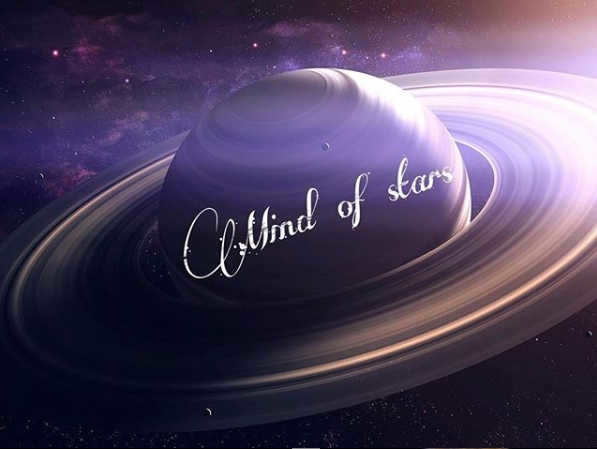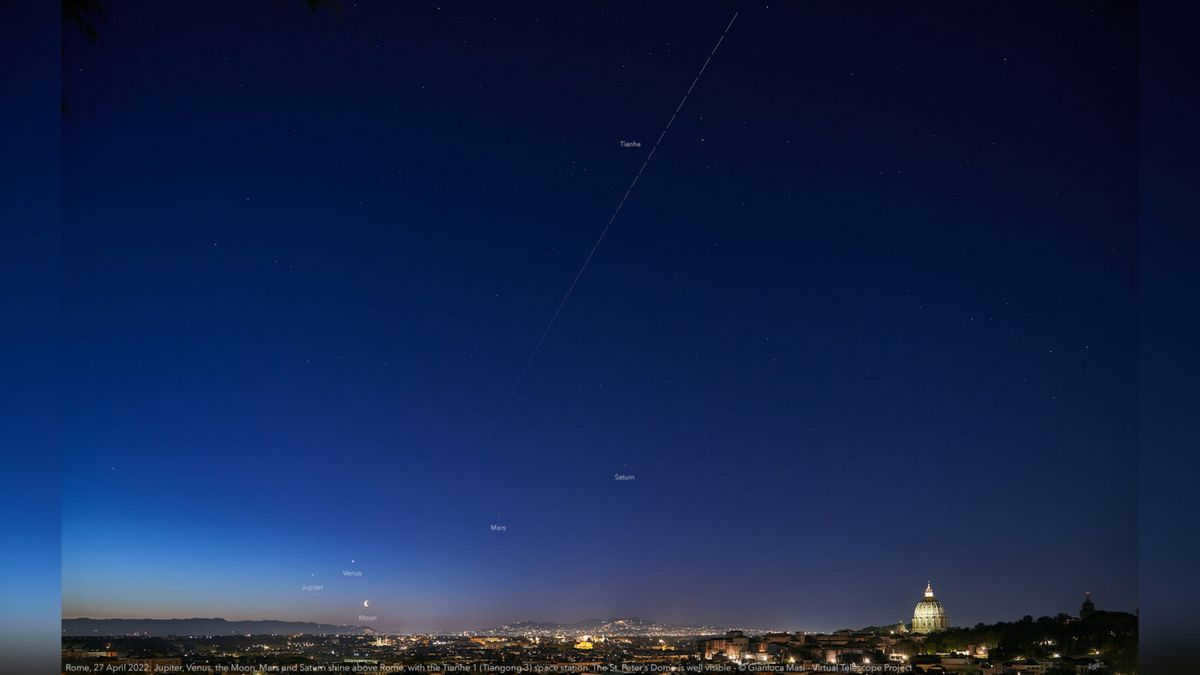
The celestial event, which will also be visible to the naked eye, is not a genuine alignment of the planets. Unlike last summer, when Mercury, Venus, Mars, Jupiter, and Saturn formed a straight line after an 18-year hiatus, this time the planets will not be positioned in a direct line from the perspective of the Sun.
Nonetheless, it will provide an opportunity to witness all five planets of the solar system simultaneously in the same area of the sky before the next true alignment, which is anticipated in 2040.
Discovering the whereabouts of the five planets
A fascinating celestial event is about to take place, as Jupiter, Mercury, Venus, Uranus, and Mars align in the sky next to a crescent moon. However, observing this spectacle may prove challenging without the aid of a telescope.
If you find yourself under clear skies with an unobstructed view of the horizon, you may have the chance to spot Jupiter and Mercury approximately one hour after sunset. These two planets will be situated in the western part of the sky, still reflecting the Sun’s fading light. As the evening progresses, they will gradually disappear below the horizon.
Venus, on the other hand, will be much easier to locate, as it is the brightest planet in this group. It will be positioned high in the sky, making it more visible than its neighboring planet, Uranus, which will be significantly fainter.
As the night progresses, Mars will come into view, shining near the Moon. Its distinctive reddish hue will make it easy to identify, as it sits among the stars of the Taurus constellation.
It is important to note that this lineup does not include Saturn and Neptune, as they are only visible in the early hours of dawn.
Are you in need of binoculars?
Jupiter, Venus, and Mars can be easily observed as they shine brightly. Venus is already one of the most luminous objects in the evening sky, while Mars will be in close proximity to the Moon, displaying its distinct reddish hue.
On the other hand, locating Mercury and Uranus will prove to be more challenging as they will be quite dim. Particularly for the latter, it is recommended to use binoculars or a small telescope. Since they are rarely visible in the sky, this presents a wonderful opportunity to search for Uranus’ green glow just above the planet Venus.
The March 2023 Planetary Parade
The celestial event known as the “parade” of planets within our solar system has already commenced. Since a few evenings ago, just after sunset, one can observe the brilliance of Venus and the reddish hue of Mars perfectly aligned in the western sky. Simultaneously, Jupiter, Mercury, and Uranus are also joining the procession. As the Moon slowly moves, it becomes an integral part of this magnificent planetary dance.
Until March 30th, at least four of these planets will remain visible, although it is best to use binoculars or a small telescope to fully appreciate their presence. The main challenge lies in witnessing all of them together on a single evening, as this requires clear skies and an unobstructed view of the western horizon.
The evening between the 27th and 28th of March is particularly favorable for attempting to witness (and capture in photographs, if desired) the complete parade.
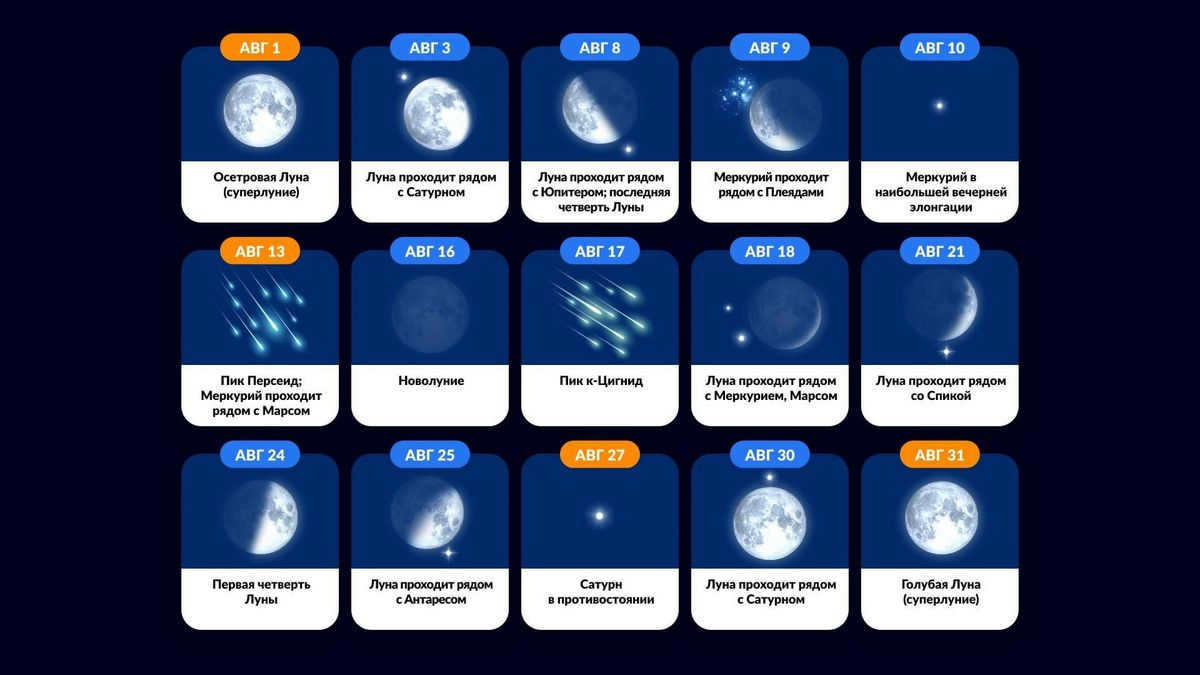
During the month of August in the year 2023, stargazers will have the opportunity to witness a remarkable display of celestial phenomena. Among the highlights are a pair of extraordinary super moons, an exceptional meteor shower that ranks among the best of the year, and the majestic planet Saturn shining with unparalleled brilliance. These are just a few of the awe-inspiring astronomical events that await those who take the time to explore the night sky during this period. For a comprehensive list of these captivating occurrences, continue reading!
Astronomical events in August 2023
The dates of the events are presented in Greenwich Mean Time. To find out the exact timing of an event in a specific location, you can use the Sky Tonight app.
- Aug. 1: Sturgeon Moon (super moon). 🌟
- August 3.: The Moon comes within 2°28' of Saturn (sidereal magnitude 0.6).
- August 8.: The Moon approaches Jupiter at a distance of 2°39' (sidereal magnitude -2.4); the Moon is in its last quarter.
- August 9.August 9: The Moon passes 1°30' from the Pleiades (sidereal magnitude 1.2).
- August 10: Mercury reaches its maximum evening elongation.
- August 13: The Perseid meteor shower will reach its peak with a Zenithal Hourly Rate (ZHR) of 100 🌟. Additionally, the Moon will pass 1°42′ away from Pollux, which has a sidereal magnitude of 1.2. Venus will be in lower conjunction with the Sun, and Mercury (sidereal magnitude 0.4) will pass 4°42′ from Mars (sidereal magnitude 1.8).
- August 16: There will be a New Moon.
- August 17: The κ-Cignidus meteor shower will reach its peak with a ZHR of 3.
- August 18: The Moon will pass 6°56′ from Mercury (sidereal magnitude 0.7) and 1°55′ from Mars (sidereal magnitude 1.8).
- August 21: The Moon will pass 2°36′ from Spica, which has a sidereal magnitude of 1.0.
- August 23: Mercury will begin its retrograde motion.
- August 24: The Moon will be in the first quarter.
- August 25.: On this day, the Moon will be just 1°6' away from Antares, which has a sidereal magnitude of 1.1. Additionally, the Moon will cover Antares, making it visible from the U.S., Mexico, and Canada.
- August 27.: Get ready for Saturn in opposition, a spectacular event that occurs when Saturn is directly opposite the Sun in the sky. 🌟
- August 29.: Uranus will start its retrograde motion on this day, creating interesting celestial dynamics.
- August 30.: Look out for the Moon passing within 2°16' of Saturn, which has a sidereal magnitude of 0.4. It will be a beautiful sight to behold.
- August 31.: Don’t miss the Blue Moon, also known as a super moon. It’s a rare phenomenon that you won’t want to miss. 🌟
More: Discover more about these fascinating astronomical events and how to make the most of them with the Sky Tonight app’s calendar. Watch our video guide to learn all about its features.
Planets in August 2023
Northern Hemisphere
Mercury (with a sidereal magnitude of 0.5) can be observed low in the evening sky in the Leo constellation. In the morning, towards the end of the month, Venus (with a sidereal magnitude of -3.9) will be visible in the eastern direction, specifically in the Cancer constellation. Moving on, Mars (with a sidereal magnitude of 1.8) can be seen in the western sky during the evening, initially in the Leo constellation and then transitioning into the Virgo constellation. If you look towards the morning sky, you’ll be able to spot Jupiter (with a magnitude of 2.3) in the Aries constellation. Additionally, Saturn (with a sidereal magnitude of 0.6) will be visible throughout the night in the Aquarius constellation. For those who are interested in observing Uranus (with a magnitude of 5.7), it can be found in the morning sky within the Aries constellation. Lastly, Neptune (with a sidereal magnitude of 7.8) will be visible throughout the night in the Pisces constellation. It’s important to note that in order to observe Uranus and Neptune, binoculars or telescopes are necessary.
South of the Equator
Observe the evening star Mercury (with a sidereal magnitude of 0.5) in the western sky, located in the constellation Leo. Venus (with a magnitude of -3.4) can also be seen in the evening, low in the west in Leo. As the month progresses, Venus transitions into a morning object, appearing low in the eastern sky in Cancer. Look for Mars (with a sidereal magnitude of 1.8) in the evening, first in Leo and then in Virgo. The mighty planet Jupiter (with a sidereal magnitude of -2.3) is visible both in the evening and morning, residing in Aries. Saturn (with a sidereal magnitude of 0.6) can be found in Aquarius during the nighttime and early morning hours, until mid-month. Towards the end of the month, Saturn is visible throughout the night. If you wish to catch a glimpse of Uranus (with a magnitude of 5.7), look for it in the morning sky in Aries. Finally, Neptune is visible at night and in the morning, situated in the constellation Pisces. It is important to note that while the other planets can be seen with the naked eye, Uranus and Neptune can only be observed with the help of optical instruments.
August 2023 Constellations
During the month of August, those located in the Northern Hemisphere have the opportunity to observe the Swan, Lyra, and Eagle constellations high in the sky. The three brightest stars within these constellations create a well-known star formation known as the Summer Triangle. Although visible throughout the year, the optimal time for observation falls between July and September.
Throughout the winter months, individuals in the Southern Hemisphere can witness the presence of the zodiacal constellations Scorpio and Sagittarius, as well as Serpentor, often referred to as the 13th zodiacal constellation.
Keep in mind that the position of constellations in the sky changes with each passing season. To determine when specific constellations are most visible throughout the year, we recommend referring to our articles on seasonal constellations for both the Northern Hemisphere and Southern Hemisphere.
Double Dose of Super Moons in August 2023
August is set to dazzle us with not just one, but two magnificent full moons! And what makes them even more spectacular is the fact that both of them will be super full moons. During this time, the Moon will come exceptionally close to Earth, resulting in a breathtakingly bright and noticeably larger appearance.
The first full moon, known as the Sturgeon Moon, will grace the night sky on August 1. Although the lunar disk will appear full the day before and after this date, August 1 is the official night to witness its grandeur. Keep an eye out for the Moon in the captivating constellation of Capricorn.
On August 31, the Moon will enter its full phase once again, this time in the constellation of Aquarius. This particular full Moon will be extra special, as it will be the closest it has been to Earth all year and will appear larger and brighter than any other full moon in 2023. Interestingly, when there are two full moons in one month, the second one is often referred to as a Blue Moon.
If you’re curious about the significance of the names given to the full moons in August and the different lunar phases of this month, be sure to check out our informative article. It’s worth noting that while the term “Blue Moon” doesn’t actually describe the moon’s color, our natural satellite can indeed change color in the sky. Take our quiz to find out what color the Moon can be!
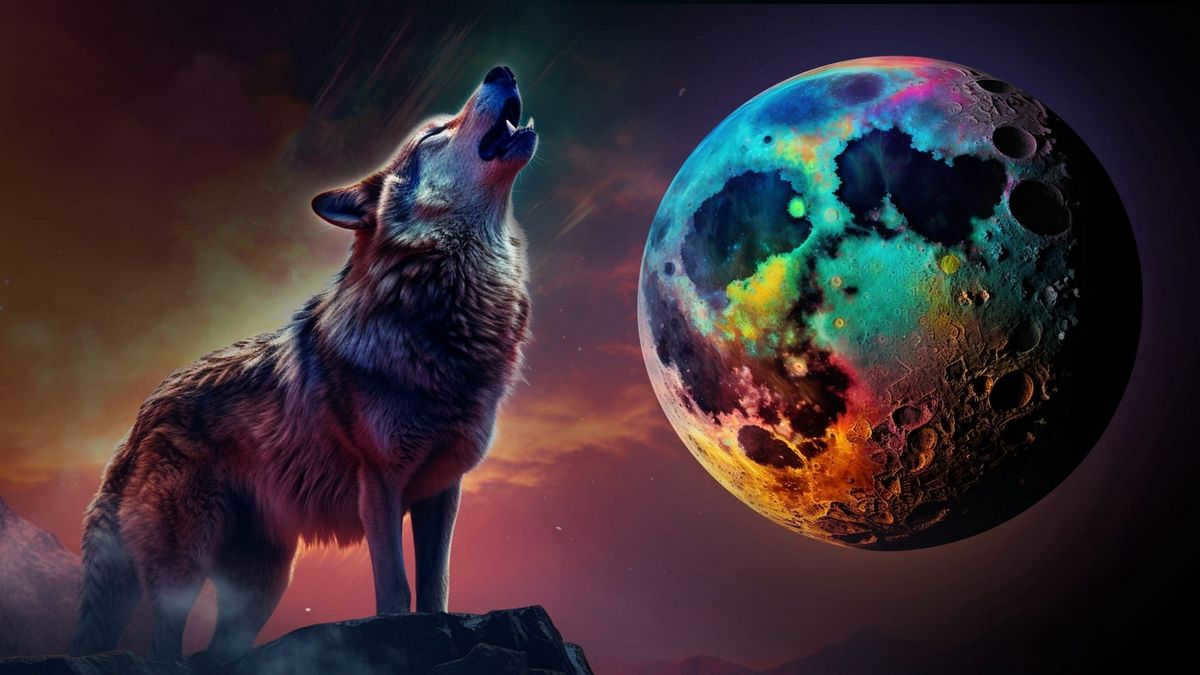
Put your knowledge of the different hues of the moon to the test! 🌕🌈 Only 15% achieve the highest score in our lunar quiz. Can you join their ranks?
Meteor showers in August 2023
There are two notable meteor showers that will reach their peak this month: the Perseids on August 13 and the Kappa Cygnids on August 17. The brightness of the moon will not hinder observations, as our satellite will be barely visible in the sky during these days.
The Kappa Cygnids will be relatively weak, but a few meteors will still be observable. The Perseids, on the other hand, will be the true highlight of the month. Known for their brilliance and abundance of meteors, they are one of the most captivating meteor showers of the year. Allow us to provide you with further details about them.
Perseids meteor shower in August 2023
During the peak period, observers will have the opportunity to witness the spectacle of up to 100 meteors streaking across the night sky in just one hour. According to the International Meteor Organization, this peak will occur on August 13, spanning from 07:00 to 14:00 GMT.
However, it is important to note that the Perseids meteor shower is not confined solely to its peak timeframe – it is renowned for sporadic bursts of activity. For instance, in the year 2021, an unexpected surge in meteor activity took place a day and a half after the anticipated maximum, resulting in over 200 meteors being observed within a single hour.
Looking ahead to 2023, there is an intriguing event to anticipate. On August 14, between 01:00 and 02:45 am GMT, the Earth will traverse an ancient path of debris that was left behind by the Swift-Tuttle comet in 68 BC. This cosmic encounter has the potential to trigger another meteor outburst, although precise predictions regarding the number of meteors are not yet available. Nevertheless, this event promises to be a captivating sight that is well worth observing. Additionally, a minor increase in activity is expected around 03:00 am GMT on August 13.
The best time to view the Perseids meteor shower is from mid-northern latitudes. The radiant, or the point in the sky where the meteors appear to originate from, will be at its highest point around 10-11 pm local time. However, the visibility of the meteor shower will be limited for those in the Southern Hemisphere and latitudes north of 60°N.
If you are interested in observing the Perseids meteor shower and want some guidance on how to do so, this article will provide you with helpful tips.
Observing Saturn at its Opposition in August 2023
In August 2023, there will be a remarkable celestial event known as Saturn’s opposition. This is when Saturn is directly opposite the Sun in the sky, providing a fantastic opportunity for observation. During this time, Saturn will appear exceptionally bright and larger than its usual size. Its stellar magnitude will be 0.4.
Saturn will be located in the constellation Aquarius, resembling a yellowish dot to the naked eye. To distinguish Saturn from other celestial objects, such as planets and stars, you can utilize the Sky Tonight app. By using binoculars or a telescope, you will also be able to observe Saturn’s iconic rings, which may appear unusually luminous due to the Zeliger effect. The planet will rise in the east during sunset and remain visible throughout the entire night. From August through October 2023, Saturn will continue to be an excellent subject for observation.
Comets in August 2023
Just a friendly reminder, if you want to catch a glimpse of comets in August 2023, make sure you have a good pair of binoculars or a telescope handy. It seems that the next comet visible to the naked eye won’t make an appearance until October 2024. But let’s focus on the comets that will be putting on a show this month.
Comet C/2021 T4 (Lemmon) had its closest encounter with the Sun (perihelion) in July, and now it’s making its way across the sky. If you’re in the Northern Hemisphere, you might be able to spot it, although it’s quite low. However, if you’re in the Southern Hemisphere, you’ll have a better chance of seeing it as it rises higher. With a stellar magnitude of approximately 9, this comet can be observed through binoculars from locations with minimal light pollution. To help you locate it, you can use the Sky Tonight app. If observing this comet interests you, don’t wait too long. It won’t be visible after September 2023.
The comet C/2023 E1 (ATLAS) was initially detected in March of this year. It rapidly increased in brightness, going from a magnitude of 12 in May to a magnitude of 9 in July. It will remain easily visible from the Northern Hemisphere throughout August and will become visible in the Southern Hemisphere, with a magnitude of approximately 10-11, for the entire month. However, it is predicted to fade quickly and will become dimmer than a magnitude of 18 by November. So, be sure to observe the comet C/2023 E1 (ATLAS) before it becomes too faint!
The comet C/2020 V2 (ZTF) is an excellent target for observers in the Southern Hemisphere. It can also be seen in the Northern Hemisphere during the summer months as it passes through the constellations of Kita and Eridanus. In August 2023, it is expected to maintain a magnitude of approximately 9-10, making it a fascinating sight.
Make sure to keep watch for the Comet C/2021 S3 (PANSTARRS). It is anticipated to become brighter and reach a magnitude of 7th in early 2024! Starting in August, individuals in the Southern Hemisphere will have the opportunity to observe it during the morning hours, although it will be at a low magnitude of 13. Northern Hemisphere residents will have to wait until November for it to become visible. By the end of 2023, the comet may become even brighter, potentially reaching a magnitude of 8.5.
How can I locate celestial objects in the sky?
If you are wondering how to locate celestial objects in the sky, you can make use of the Sky Tonight mobile application, which is an interactive sky map. This application is absolutely free and has a vast and regularly updated database. The best part is that it can be used even without an internet connection, making it ideal for outdoor activities such as camping trips or picnics. Simply open the app, point your phone towards the sky, and it will display the objects that are visible. For a more in-depth exploration of the night sky, we also offer video tutorials that provide clear explanations on how to search for celestial objects and more.
Summarizing the Exciting Astronomical Events in August 2023
Get ready for a month full of fascinating celestial phenomena! August 2023 is set to showcase the year’s largest super moon, the breathtaking Perseids meteor shower, captivating moon-planet conjunctions, Saturn shining at its brightest, and much more. To effortlessly explore the night sky, make sure to download the Sky Tonight app.
While everyone can marvel at various celestial bodies with a magnitude of +6m, there are individuals blessed with an eye angular resolution exceeding 1′.
Throughout history, there have been unverified accounts suggesting that certain individuals could spot Uranus without the aid of a telescope. It is worth noting that Uranus was the first planet discovered after the invention of the telescope.
What is visible in the night sky?
When the night sky is clear, there are numerous objects that can be seen. On a clear night, a person can see approximately 2500 stars. However, due to celestial dust, this number is reduced to around 2000. In highly populated cities, the number of visible stars is further reduced to about 500. It is fascinating to note that celestial bodies have their own distinct colors, although only very bright planets can be observed with the naked eye.
Without the aid of a telescope, one can still observe certain clusters of stars. Examples include the globular clusters of Centauri and 47 Tucana, as well as the Magellanic clouds – both the Small and Large. Additionally, several planets can be seen without a telescope, including Mercury, Venus, Mars, Saturn, and Jupiter.
During specific times of the year, meteor streams are also visible. The Geminids meteor shower is particularly clear in December, while the Perseids can be seen in mid-August. Furthermore, approximately 100 satellites can be spotted in the night sky, including the Milky Way and the International Space Station.
Exploring the inner planets
There are two categories of planets based on their position relative to the Earth’s orbit. The inner category consists of Venus and Mercury, making them visible in the sky during the evening and early morning.
By observing these planets, we can observe their gradual departure from the Sun until they reach their maximum distance. After that, the planet returns to its original position, and its visibility disappears in the morning twilight.
When it comes to Venus, it can remain visible for several months, while Mercury can only be seen for a few weeks. When moving away from the Sun, the angular distance is 28 degrees, and when it is closest, it is 18 degrees. Nevertheless, this planet can still be observed with the naked eye.
The distance between Venus and the Sun can reach up to 47 degrees. With a brightness level of -4m, Venus is visible even during daylight hours. This implies that when the sun is out, particularly in the spring and summer, Venus appears high in the sky and can be observed from Earth without the need for special equipment.
Planets beyond Earth in the celestial sphere
The motion of these prominent celestial bodies in the field of astronomy is classified according to the following concepts:
- Conjunction;
- Stationary;
- Opposition;
- Direct motion;
- Retrograde motion.
These conditions can be exemplified by Jupiter. When it is in conjunction with the Sun, it means that the angular separation between them is at its minimum. As a result, Jupiter is not visible during daylight hours without the aid of a telescope. However, after a few weeks, it can be observed in the morning sky towards the east.
At present, the planet is in a state of linear motion away from the Sun, proceeding from the West to the East. Although it may appear that the Sun is also moving in a similar manner, the planet’s slower pace results in a significantly larger angular distance. As a result, Jupiter is visible for a longer duration each night, appearing deep into the night sky.
After a certain period of time, Jupiter gradually decelerates and eventually comes to a halt. This phenomenon is known as the standing of Jupiter. Subsequently, the planet reverses its motion and begins moving in the opposite direction from the East to the West, referred to as retrograde motion.
When the angular distance between Jupiter and the Sun reaches 180 degrees, they will occupy opposite positions in the celestial sphere – a state known as opposition. During this period, the planet is observable under the most favorable conditions. Jupiter then proceeds to a new standing point.
Following such a celestial loop, the planet undergoes a straight easterly movement, with the Sun subsequently catching up to it. Shortly thereafter, Jupiter becomes nearly imperceptible during the evening twilight. This marks the conclusion of the planet’s visibility period. Following its conjunction with the Sun, the planet will become visible in the early morning, resuming its typical trajectory of motion.
Characteristics of the planets
Those who know where to look can easily observe Venus, Mars, and Jupiter in the nighttime sky. Venus, in particular, stands out as the brightest star after the Sun and the Moon. Jupiter, on the other hand, is the largest planet in the sky and its yellowish glow distinguishes it from the surrounding white and blue stars.
Saturn and Mars are often mistaken for small stars due to their distant location from Earth and relatively small size. It is best to look for them during the late night, as they may be difficult to spot in the evening or morning.
No star charts in the world can accurately depict the locations of the planets, as they are constantly moving. However, careful observation of the night sky will reveal their gradual movement within the zodiacal constellations.
Many people who occasionally gaze at the celestial canopy are often unaware that they are not only beholding stars, but also planets like Venus and Mercury, Jupiter and others. Due to their wandering nature, the planets occupy different positions each time. Depending on their motion phase, they can be spotted at various times of the day in the firmament.
Interesting information
In the month of November, sky enthusiasts will have the opportunity to witness a rare occurrence – all seven planets of our solar system will be visible to the naked eye..
The brightest among them will be Venus, but you will also be able to spot Mercury, Mars, Saturn, and Jupiter.
If you want to catch a glimpse of Uranus and Neptune, make sure to have a pair of binoculars handy.
Mars, Saturn, and Jupiter are most visible in the evening, while the ideal time to observe Venus is in the morning.
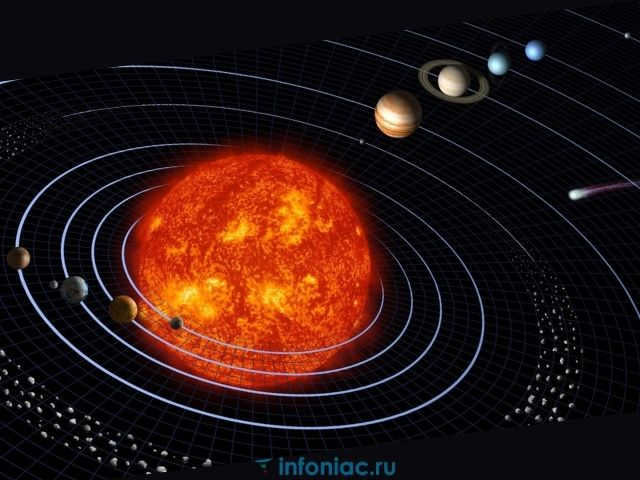
Mercury
In the first weeks of November, people in the northern hemisphere will have the opportunity to observe Mercury in the morning sky.
On November 10, the planet will reach its maximum morning elongation, positioning itself 19 degrees west of the Sun.
Elongation refers to the angle formed between the Sun and the planet from the viewpoint of an observer standing on Earth. To illustrate, imagine you are gazing up at the sky and you spot the Sun, slightly to the left of it you see a bright planet. If you were to draw a triangle connecting yourself, the Sun, and the planet, the angle of the triangle at your position would represent the elongation.
Venus
Venus is set to become the most luminous planet in the night sky.
It has already reached its maximum distance from the Sun on August 12-13. Nevertheless, the planet will continue to shine brightly and be visible to the naked eye for the remainder of this year. The visibility of Venus depends largely on your location.
- In the middle latitudes of the northern hemisphere, Venus will be observable for three hours in early November and 2.5 hours before sunrise at the end of the month.
- For those residing closer to the equator, Venus will be visible for 2 hours at the start of the month and 1.55 minutes before sunrise towards the end.
Although Venus will have dimmed by almost half of its brightness compared to July by mid-November, its apparent magnitude will still be -3.9, making it significantly brighter than other planets.
You will be able to easily identify Venus as a nearby “star” to Mercury.
Keep an eye out for the decreasing Moon in the early morning sky, joined by Venus and Mercury on November 12-13.
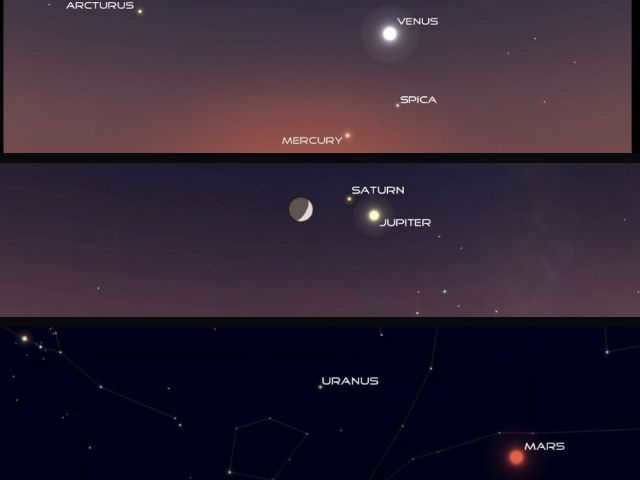
Mars
In October, Mars took center stage with its unprecedented brightness, and unfortunately, we won’t have the opportunity to witness this phenomenon again until September 2035.
During this time, Mars reached opposition, which means it was positioned directly opposite the Sun from the perspective of an observer on Earth.
As Earth’s orbit is smaller than that of Mars, we are currently moving farther away from the red planet, causing it to gradually fade in the night sky.
If you gaze up at the sky at this moment and spot a radiant red “star,” chances are it is none other than Mars.
Jupiter and Saturn
In November, after the Sun goes down, you will have the opportunity to witness Jupiter and Saturn. You will have the chance to observe them for the remainder of the year.
In the middle latitudes of the Northern Hemisphere, Jupiter and Saturn will disappear in the middle of the evening, whereas in the Southern Hemisphere, they will stay visible until late at night.
During December 2020, a remarkable event called “the Grand Conjunction” of these two planets will take place. This occurrence only happens once every 20 years. This year’s conjunction will be the most significant since 1623.
Throughout November, both Jupiter and Saturn will shine brightly. They will gradually move lower as the Sun sets. If you happen to have a telescope, you can use it to observe these planets and obtain a clearer view of them.
Jupiter outshines Saturn by a significant margin, making it the ideal celestial body to locate first before using it as a navigational aid to find Saturn. To catch a glimpse of the rings and moons surrounding these planets, a telescope will be a necessary tool.

Uranus and Neptune
Both Uranus and Neptune will be visible during the evening hours in November, but they may be challenging to observe without additional assistance.
To see Uranus, you will need a pair of binoculars, and to observe Neptune, a high-quality telescope or long-range binoculars are recommended.
Uranus has a blue-green color and appears slightly larger and brighter later in the evening during early November.
As the night sky becomes darker with the decreasing Moon phase, spotting Neptune will become easier.
To determine the precise direction to look, you can utilize a night sky map application that can provide the positions of stars and planets based on your location.
Prepare yourself for a breathtaking celestial display!
- space – An overview of the planets that are visible in the night sky
- news.yahoo – Discover the 7 planets that can be seen in the dark sky

The Sun is a celestial body located in the Milky Way Galaxy and is the sole star in our Solar System. The Sun serves as the gravitational center for various objects within the solar system, including planets, their moons, dwarf planets, asteroids, meteoroids, comets, and space dust. Notably, the Sun is the star nearest to Earth.
Throughout history, humanity has acknowledged and revered the Sun for its crucial role in providing light and warmth. Numerous prehistoric and ancient cultures worshipped the Sun as a divine entity, attributing great significance to its presence. The veneration of the Sun held a prominent place within the religious beliefs of many civilizations.
It is only possible to observe the Sun without damaging your vision at sunrise or sunset, when the brightness of the Sun is weakened by several thousand times. Alternatively, during the day, you can use light filters to protect your eyes. When using binoculars or telescopes for amateur observations, it is also important to use a darkening light filter in front of the lens. However, a more effective method is to project the image of the Sun through the telescope onto a white screen. This allows for the study of sunspots, as well as the observation of granulation and flares on the Sun’s surface, even with a small amateur telescope. However, it is important to note that this method carries a risk of damaging the telescope itself, so it is advisable to read the telescope’s manual before attempting it.
Undoubtedly, you have witnessed the enchanting splendor of the MOON.
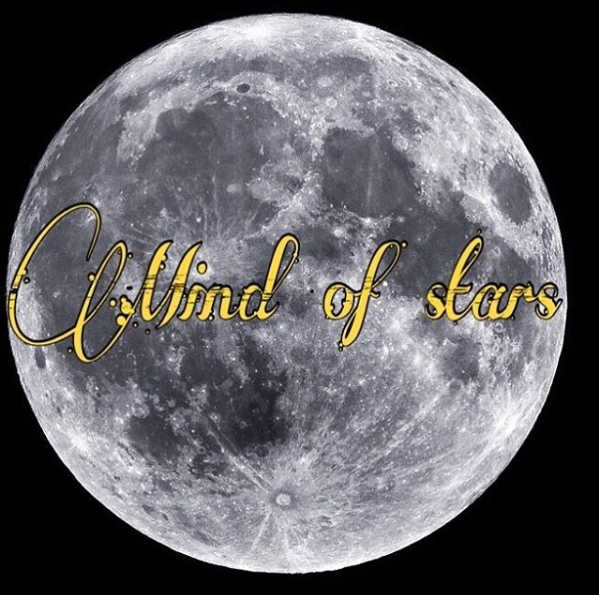
The Moon is one of the celestial bodies in the Solar System that can be observed without the aid of a telescope. It is the second most luminous entity in the Earth’s atmosphere, second only to the Sun.
The Moon is the sole extraterrestrial celestial object that has been explored by humans.
The scientific community has gathered evidence to support the assertion that the Moon is gradually moving away from the Earth as a result of tidal acceleration, at a rate of 38 mm per year. This phenomenon has given rise to a slowly unfolding spiral trajectory for the Moon’s orbit.
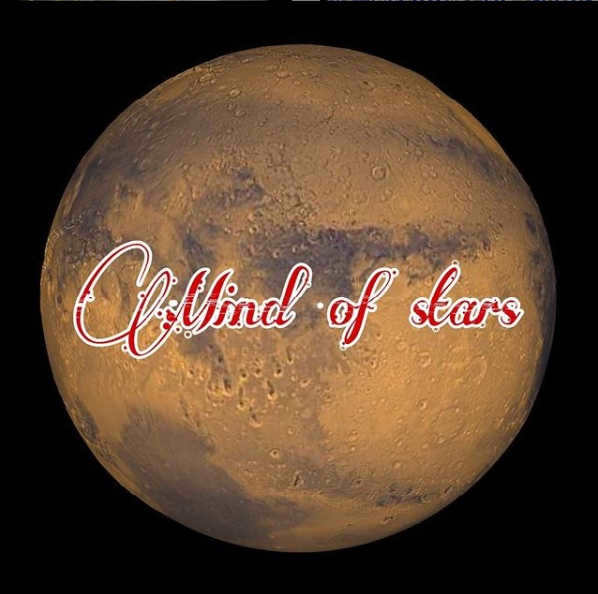
Mars, the fourth planet from the Sun, is known for its distance and size in the Solar System, ranking after Mercury, Venus, and Earth. It is the seventh largest planet, only surpassed by Mercury in terms of mass and diameter.
The planet derives its name from the ancient Roman god of war, Mars, who is equivalent to the Greek god Ares. Mars is often referred to as the “red planet” due to its distinct color.
Mars can be observed from Earth without the need for telescopes. It is the second brightest object in the sky, trailing behind only Jupiter. In some cases, during a great opposition of Mars, it can even outshine Jupiter, Venus, the Moon, and the Sun.
Typically, during a significant opposition (when the opposition aligns with the Earth and Mars reaches the closest point to the Sun in its orbit), the orange-hued Mars becomes the most prominent celestial body in the Earth’s nighttime panorama, second only to the Moon (excluding Venus, which, although brighter, is observable only in the morning and evening). However, this phenomenon transpires solely once every 15-17 years, lasting for a brief span of one to two weeks.
MERCURY. Have you observed it in the celestial expanse?
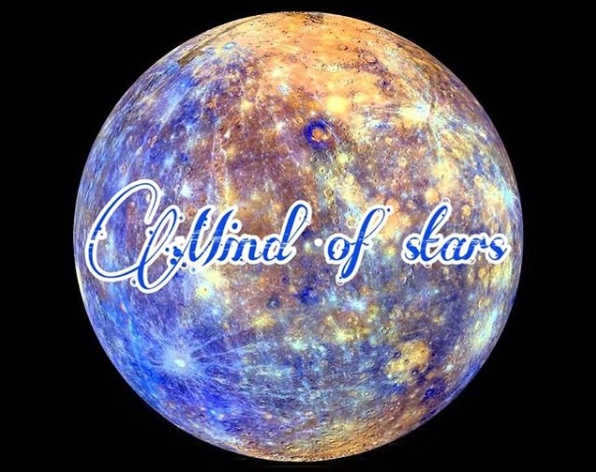
Mercury, the planet closest to the sun in our solar system, takes its name from the ancient Roman god of commerce.
Mercury has a shimmering, bright yellow color. Due to its close proximity to the sun, it is often difficult to see Mercury as it gets overshadowed by the sun’s strong glow. However, during mid-August, this planet becomes more visible.
The best conditions for observing Mercury are in regions with low latitudes and near the equator, as the duration of twilight is shorter there. In areas with middle latitudes, spotting Mercury is more challenging and can only be done during the best elongations. At high latitudes, it is rare to see Mercury in the dark night sky, except during eclipses when it is visible for a very short period of time after dusk.
Have you ever laid eyes on Jupiter in the celestial expanse?
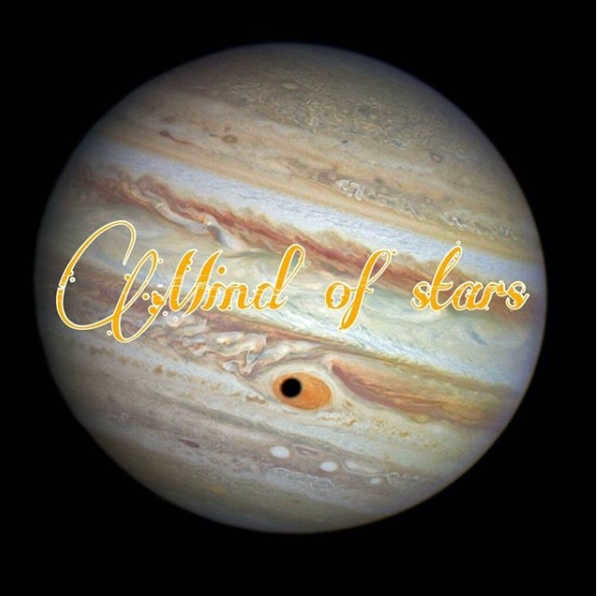
Jupiter, the largest planet in the solar system, has been known to humans for centuries, and its significance can be found in the mythology and religious beliefs of various cultures. The name Jupiter originates from the ancient Roman god of thunder, reflecting the planet’s power and majesty.
Each planet has its unique color spectrum when reflecting sunlight, making it easy to identify them. Jupiter, for example, appears white and stands as the second brightest celestial object in the night sky.
Observing Jupiter is best done at dawn, and during great oppositions, it becomes one of the most prominent objects visible to the naked eye, surpassed only by the Moon and Venus.
Due to its relatively short rotation period of about 10 hours, it is possible to observe the entire planet in a single night using a telescope.
VENERA. Have you observed it in the celestial dome?
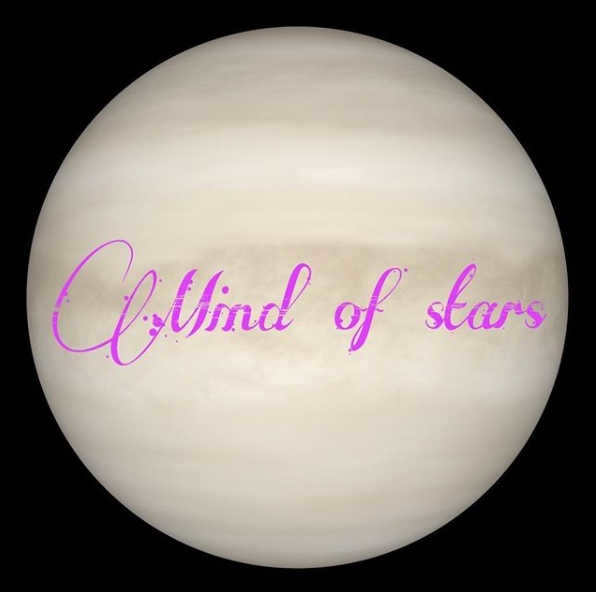
Venus, the second most distant planet from the Sun in our solar system, derives its name from the ancient Roman goddess of love, Venus.
It ranks as the third most luminous celestial body in the Earth’s atmosphere, surpassed only by the Sun and the Moon. Venus often appears shortly before sunrise or after sunset, traditionally referred to as the “morning star” and “evening star” respectively.
Its extraordinary brilliance sets it apart from even the brightest stars, and its distinctive characteristic is its uniform white hue.
Due to its disc-like shape and silver hue, many individuals mistake Venus for an unidentified flying object (UFO).
